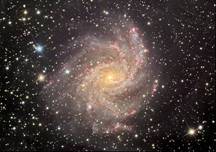The planetary conjunction isn't over yet. Venus, Jupiter, and Mercury will be hanging around in the west-northwestern sky for a few more days. Last night I saw them less than 10 degrees above the horizon but could follow them all the way to sunset. On the night of May 26th they made a perfect equilateral triangle as shown by the picture below.
Over the next few days, Venus and Mercury will appear higher at the same time of night while Jupiter sinks lower. Venus is the brightest of the three, followed by Jupiter, and then Mercury. Over the next few days Venus will slide between the other two turning the former triangle into a planetary lineup. May 31 and June 1 they will be best aligned. Jupiter will be at the bottom, Venus in the middle, and Mercury at the top. Both Mercury and Venus and Venus and Jupiter will be separated by only 4 degrees. On June 1, Mercury will be the closest of the three at about 95 million miles away, Venus is on the other side of the Sun from us still so it's about 151 million miles distant, while Jupiter is way out as usual - 567 million miles away.
Jupiter will be heading off into the sunset soon so don't miss it. Mercury will hang around for a few more weeks and make a close conjunction with Venus on the night on June 18 and 19. But Venus will be low in the evening skies for the next several months. In fact, she'll be there even as you ring in the New Year 2014.
To see the planets you will need an extremely clear view to the west-northwest horizon. No trees, buildings or anything can be in your way. And you have to be there right after sunset. Once the Sun sets you only have 30 minutes to catch the planets pop out from the sky glow before they set.
Happy Planet Hunting!
-
The Mythology of the Constellations and Much More

About This Site
I'm Dean Regas from the Cincinnati Observatory and welcome to Deanspace. This is a site to share the mythology of the stars and constellations. Each week I will post a new myth related to a constellation visible in the night sky along with some images taken by Cincinnati area amateur astronomers, and astronomy pictures of the day.
Horsehead Nebula

Photo by Eric Africa








